height adjustment OPEL CORSA 2017 Manual user
[x] Cancel search | Manufacturer: OPEL, Model Year: 2017, Model line: CORSA, Model: OPEL CORSA 2017Pages: 267, PDF Size: 8.01 MB
Page 9 of 267
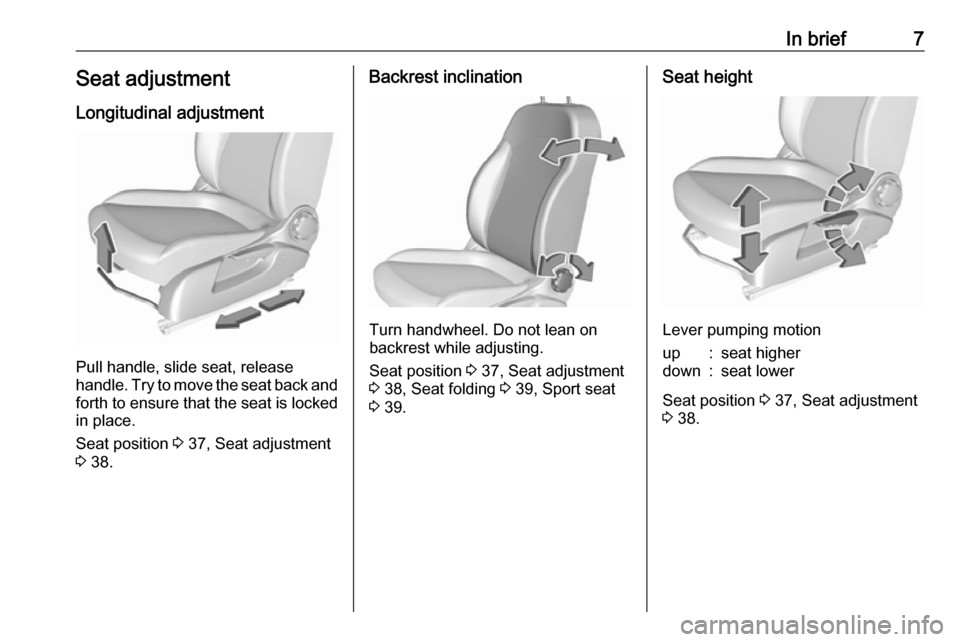
In brief7Seat adjustmentLongitudinal adjustment
Pull handle, slide seat, release
handle. Try to move the seat back and forth to ensure that the seat is locked
in place.
Seat position 3 37, Seat adjustment
3 38.
Backrest inclination
Turn handwheel. Do not lean on
backrest while adjusting.
Seat position 3 37, Seat adjustment
3 38, Seat folding 3 39, Sport seat
3 39.
Seat height
Lever pumping motion
up:seat higherdown:seat lower
Seat position 3 37, Seat adjustment
3 38.
Page 10 of 267
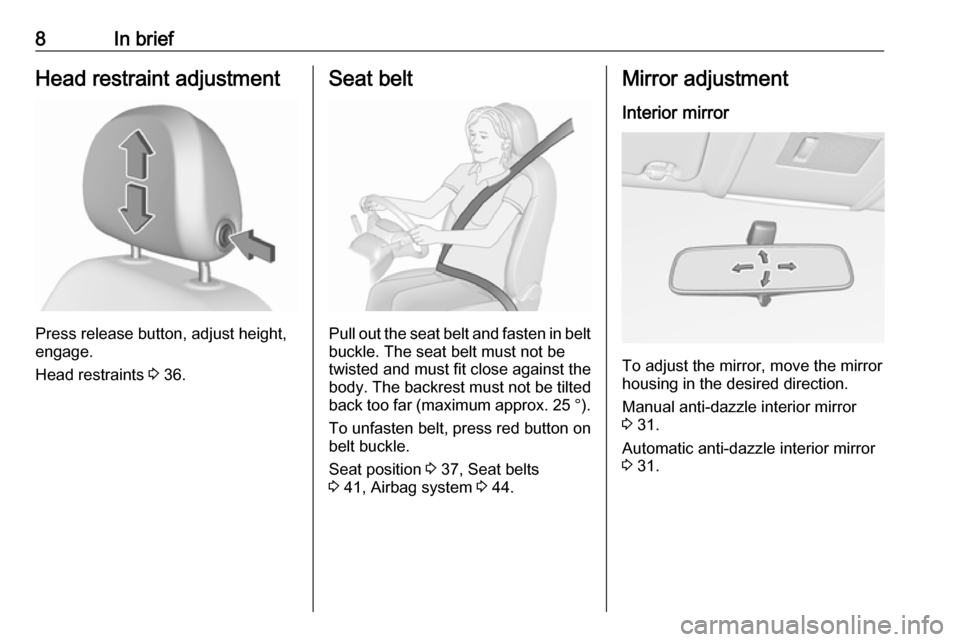
8In briefHead restraint adjustment
Press release button, adjust height,
engage.
Head restraints 3 36.
Seat belt
Pull out the seat belt and fasten in belt
buckle. The seat belt must not be
twisted and must fit close against the
body. The backrest must not be tilted back too far (maximum approx. 25 ° ).
To unfasten belt, press red button on belt buckle.
Seat position 3 37, Seat belts
3 41, Airbag system 3 44.
Mirror adjustment
Interior mirror
To adjust the mirror, move the mirror
housing in the desired direction.
Manual anti-dazzle interior mirror
3 31.
Automatic anti-dazzle interior mirror 3 31.
Page 38 of 267
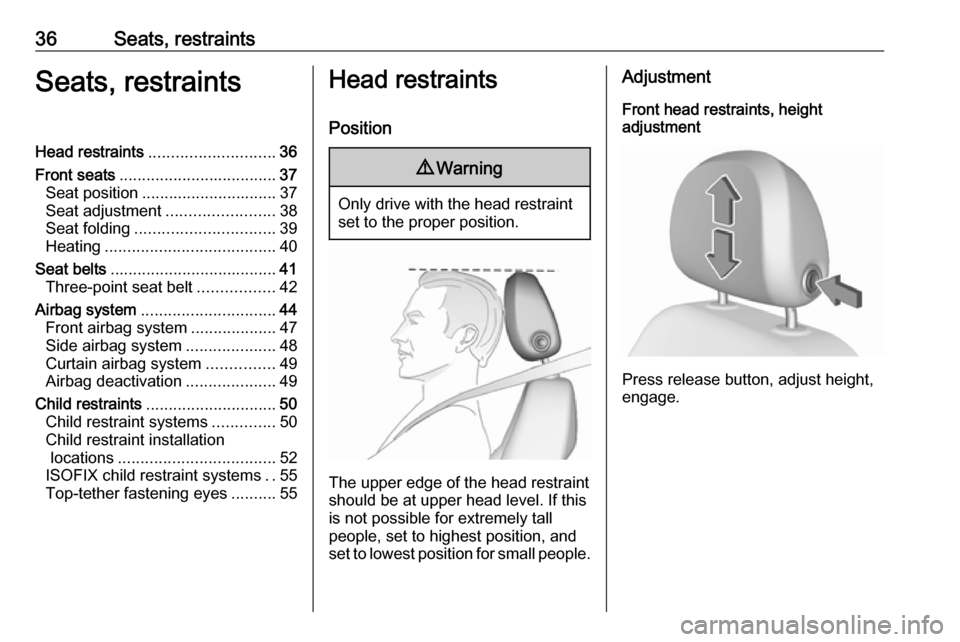
36Seats, restraintsSeats, restraintsHead restraints............................ 36
Front seats ................................... 37
Seat position .............................. 37
Seat adjustment ........................38
Seat folding ............................... 39
Heating ...................................... 40
Seat belts ..................................... 41
Three-point seat belt .................42
Airbag system .............................. 44
Front airbag system ...................47
Side airbag system ....................48
Curtain airbag system ...............49
Airbag deactivation ....................49
Child restraints ............................. 50
Child restraint systems ..............50
Child restraint installation locations ................................... 52
ISOFIX child restraint systems ..55
Top-tether fastening eyes ..........55Head restraints
Position9 Warning
Only drive with the head restraint
set to the proper position.
The upper edge of the head restraint
should be at upper head level. If this
is not possible for extremely tall
people, set to highest position, and
set to lowest position for small people.
Adjustment
Front head restraints, height
adjustment
Press release button, adjust height,
engage.
Page 39 of 267
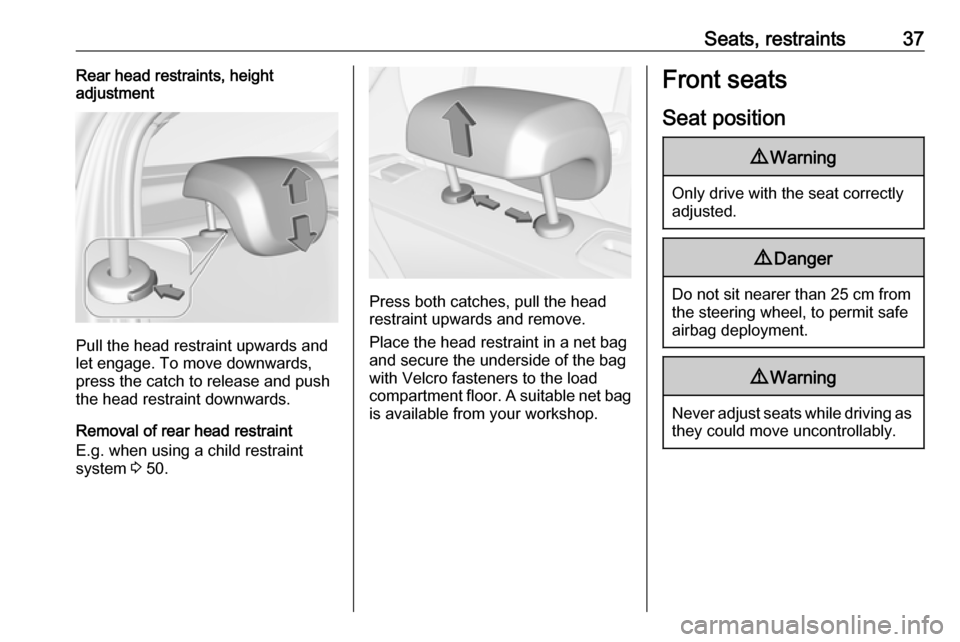
Seats, restraints37Rear head restraints, height
adjustment
Pull the head restraint upwards and
let engage. To move downwards, press the catch to release and push
the head restraint downwards.
Removal of rear head restraint
E.g. when using a child restraint
system 3 50.
Press both catches, pull the head
restraint upwards and remove.
Place the head restraint in a net bag
and secure the underside of the bag
with Velcro fasteners to the load
compartment floor. A suitable net bag
is available from your workshop.
Front seats
Seat position9 Warning
Only drive with the seat correctly
adjusted.
9 Danger
Do not sit nearer than 25 cm from
the steering wheel, to permit safe
airbag deployment.
9 Warning
Never adjust seats while driving as
they could move uncontrollably.
Page 40 of 267
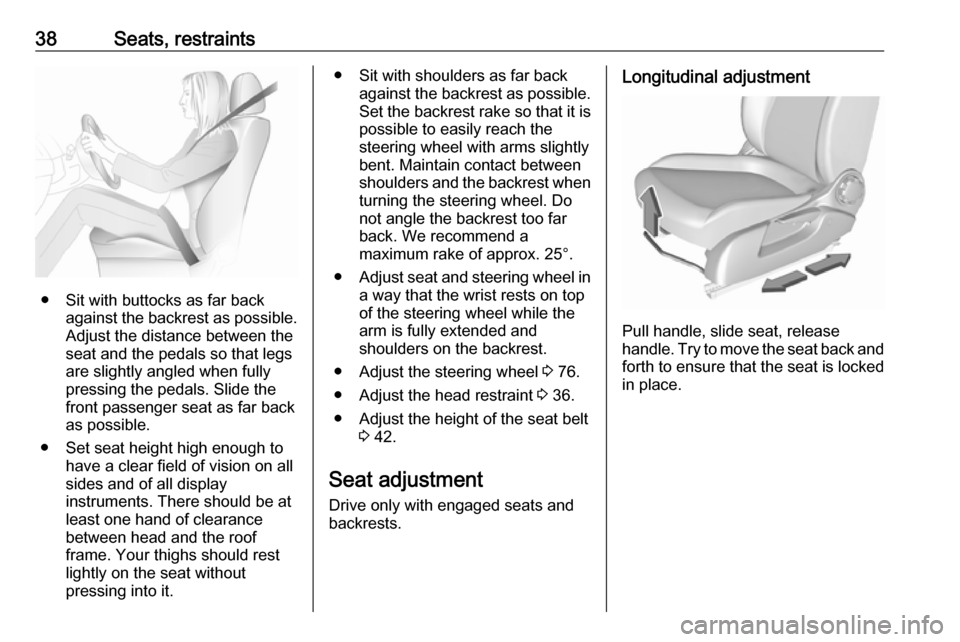
38Seats, restraints
● Sit with buttocks as far backagainst the backrest as possible.
Adjust the distance between the
seat and the pedals so that legs
are slightly angled when fully
pressing the pedals. Slide the
front passenger seat as far back
as possible.
● Set seat height high enough to have a clear field of vision on all
sides and of all display
instruments. There should be at
least one hand of clearance
between head and the roof
frame. Your thighs should rest
lightly on the seat without
pressing into it.
● Sit with shoulders as far back against the backrest as possible.
Set the backrest rake so that it is possible to easily reach the
steering wheel with arms slightly
bent. Maintain contact between
shoulders and the backrest when
turning the steering wheel. Do
not angle the backrest too far
back. We recommend a
maximum rake of approx. 25°.
● Adjust seat and steering wheel in
a way that the wrist rests on top
of the steering wheel while the
arm is fully extended and
shoulders on the backrest.
● Adjust the steering wheel 3 76.
● Adjust the head restraint 3 36.
● Adjust the height of the seat belt 3 42.
Seat adjustment
Drive only with engaged seats and
backrests.Longitudinal adjustment
Pull handle, slide seat, release
handle. Try to move the seat back and forth to ensure that the seat is locked
in place.
Page 45 of 267
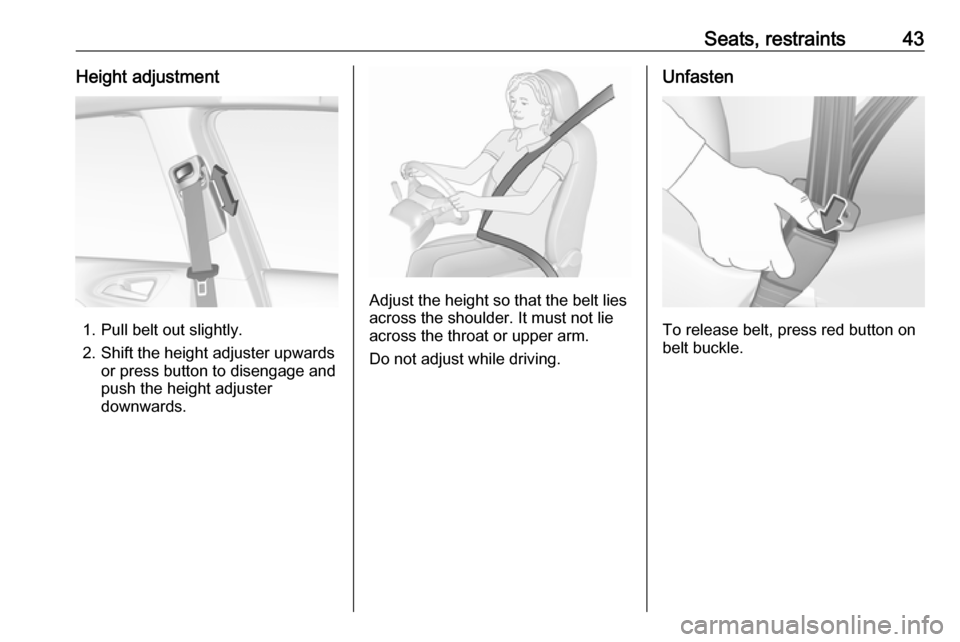
Seats, restraints43Height adjustment
1. Pull belt out slightly.
2. Shift the height adjuster upwards or press button to disengage and
push the height adjuster
downwards.
Adjust the height so that the belt lies
across the shoulder. It must not lie
across the throat or upper arm.
Do not adjust while driving.
Unfasten
To release belt, press red button on
belt buckle.
Page 54 of 267

52Seats, restraintsChild restraint installation locations
Permissible options for fastening a child restraint system with a three-point seat belt
Weight class
On front passenger seat
On rear outboard seatsOn rear centre seat
activated airbagdeactivated airbagGroup 0: up to 10 kgXU 1,2U/L 3XGroup 0+: up to 13 kgXU1,2U/L 3XGroup I: 9 to 18 kgXU1,2U/L 3,4XGroup II: 15 to 25 kgU1,2XU/L 3,4XGroup III: 22 to 36 kgU1,2XU/L 3,4XU:universal suitability in conjunction with three-point seat beltL:suitable for particular child restraint systems of the 'specific-vehicle', 'restricted' or 'semi-universal' categories. The
child restraint system must be approved for the specific vehicle type (refer to the vehicle type list of the child restraint
system)X:no child restraint system permitted in this weight class1:move seat forwards as far as necessary and adjust seat backrest inclination as far as necessary to a vertical position to ensure that the belt runs forwards from the upper anchorage point2:move seat height adjustment upwards as far as necessary and adjust seat backrest inclination as far as necessaryto a vertical position to ensure that the belt is tight on the buckle side3:move the respective front seat ahead of the child restraint system forwards as far as necessary4:adjust the respective backrest to the rearmost position 3 67 , adjust the respective headrest as necessary or remove
if required 3 36
Page 56 of 267

54Seats, restraintsX:no ISOFIX child restraint system approved for this weight class1:move seat forwards as far as necessary and adjust seat backrest inclination as far as necessary to a vertical position
to ensure that the belt runs forwards from the upper anchorage point2:move seat height adjustment upwards as far as necessary and adjust seat backrest inclination as far as necessary
to a vertical position to ensure that the belt is tight on the buckle side3:move the respective front seat ahead of the child restraint system forwards as far as necessary4:adjust the respective backrest to the rearmost position 3 67, adjust the respective headrest as necessary or
remove if required 3 365:ISOFIX/Top-tether fastening points optional for the front passenger seat (not available for sport seats)
ISOFIX size class and seat device
A – ISO/F3:forward-facing child restraint system for children of maximum size in the weight class 9 to 18 kgB – ISO/F2:forward-facing child restraint system for smaller children in the weight class 9 to 18 kgB1 – ISO/F2X:forward-facing child restraint system for smaller children in the weight class 9 to 18 kgC – ISO/R3:rear-facing child restraint system for children of maximum size in the weight class up to 18 kgD – ISO/R2:rear-facing child restraint system for smaller children in the weight class up to 18 kgE – ISO/R1:rear-facing child restraint system for young children in the weight class up to 13 kg